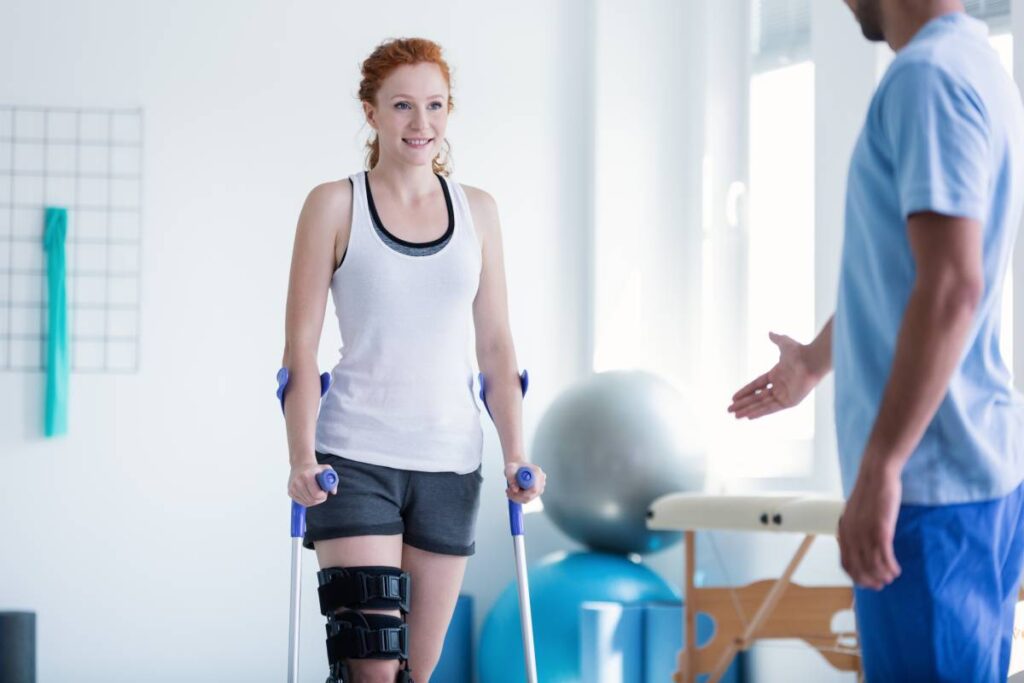Orthopedic surgery, whether for joint replacement, fracture repair, spinal correction, or another procedure, is a major medical intervention aimed at restoring mobility, reducing pain, and improving quality of life. However, the surgery itself is just the beginning of the journey toward full recovery. Rehabilitation plays a crucial role in helping patients regain strength, flexibility, and function after orthopedic surgery and must not be set aside. Understanding the rehabilitation needs after orthopedic surgery is essential for achieving the best possible outcomes.
Early rehabilitation is vital in the postoperative period, often starting within hours or days after surgery. The goals of early rehabilitation include reducing pain and swelling, preventing complications such as blood clots and pneumonia, and beginning the process of regaining mobility 1–3.
There are several key components of early rehabilitation. First, effective pain control enables active participation in rehabilitation. Pain control methods can include medications, ice therapy, and techniques such as transcutaneous electrical nerve stimulation 4,5. In addition, postoperative breathing exercises help prevent respiratory complications, particularly after spinal surgery or prolonged bed rest 6. Finally, as soon as it is safe, patients are encouraged to move. This may start with simple movements in bed, followed by sitting up, standing, and eventually walking with assistance. Early mobilization helps prevent complications like deep vein thrombosis and encourages the return of normal bodily functions 2,7,8.
Physical therapy is typically a central part of rehabilitation after orthopedic surgery, involving a range of exercises and techniques designed to restore movement, strength, and function. There are several distinct postoperative physical therapy goals. These include range of motion exercises to restore the full range of motion in the affected joint or limb, strengthening exercises to rebuild muscle mass, support the joint, and prevent future injuries, balance training to help patients regain stability, and functional exercises simulating daily activities 3.
Occupational therapy is often another aspect of postoperative rehabilitation, particularly for patients who have undergone upper extremity surgery, spinal surgery, or joint replacements. Occupational therapy focuses on helping patients regain the ability to perform daily activities such as dressing, bathing, and cooking. In occupational therapy, therapists teach patients how to adapt to their temporary or permanent limitations using assistive devices. In addition, patients learn techniques to manage fatigue and conserve energy while performing daily tasks, which is particularly important for those recovering from major surgeries. Finally, occupational therapy can also address the patient’s ability to return to work or engage in hobbies, ensuring that they can maintain a fulfilling lifestyle after surgery 9,10.
The psychological impact of orthopedic surgery should not be underestimated. Pain, reduced mobility, and the temporary loss of independence can lead to feelings of frustration, anxiety, and depression. Rehabilitation programs often include psychological support to help patients cope with these challenges. To this end, access to a psychologist or counselor can help patients navigate the emotional aspects of recovery. Furthermore, connecting with others who have undergone similar surgeries can provide emotional support and encouragement. Finally, setting realistic, achievable goals helps maintain motivation and provides a sense of accomplishment as patients progress through their rehabilitation 11–14.
Rehabilitation after orthopedic surgery can be a continuing process—long-term maintenance exercises are often essential to sustain the gains made during rehabilitation and prevent future injuries. Patients are often given home exercise programs and educated on lifestyle changes that promote joint health and overall well-being.
References
1. The Benefits of Early Rehabilitation After Surgery or an Injury. Available at: https://londonsportstherapy.com/benefits-early-rehabilitation-after-surgery/.
2. Tazreean, R., Nelson, G. & Twomey, R. Early mobilization in enhanced recovery after surgery pathways: Current evidence and recent advancements. Journal of Comparative Effectiveness Research (2022). doi:10.2217/cer-2021-0258
3. Tao, J., Yan, Z., Bai, G., Zhang, H. & Li, J. Enhanced Recovery after Surgery Rehabilitation Protocol in the Perioperative Period of Orthopedics: A Systematic Review. Journal of Personalized Medicine (2023). doi:10.3390/jpm13030421
4. Sampognaro, G. & Harrell, R. Multimodal Postoperative Pain Control After Orthopaedic Surgery. StatPearls (2023).
5. Chunduri, A. & Aggarwal, A. K. Multimodal Pain Management in Orthopedic Surgery. Journal of Clinical Medicine (2022). doi:10.3390/jcm11216386
6. Deep breathing after surgery Information | Mount Sinai – New York. Available at: https://www.mountsinai.org/health-library/selfcare-instructions/deep-breathing-after-surgery.
7. Aprisunadi, Nursalam, N., Mustikasari, M., Ifadah, E. & Hapsari, E. D. Effect of Early Mobilization on Hip and Lower Extremity Postoperative: A Literature Review. SAGE Open Nursing (2023). doi:10.1177/23779608231167825
8. Yakkanti, R. R. et al. Impact of early mobilization on length of stay after primary total knee arthroplasty. Ann. Transl. Med. (2019). doi:10.21037/atm.2019.02.02
9. Hirsch, U. & Zobel, J. Occupational Therapy in Orthopedics and Accident Surgery. Rehabil. (2018). doi:10.1055/s-0043-124391
10. Lee, S. Y., Jung, S. H., Lee, S. U., Ha, Y. C. & Lim, J. Y. Is Occupational Therapy after Hip Fracture Surgery Effective in Improving Function?: A Systematic Review and Meta-Analysis of Randomized Controlled Studies. Am. J. Phys. Med. Rehabil. (2019). doi:10.1097/PHM.0000000000001069
11. Vincent, H. K., Horodyski, M. B., Vincent, K. R., Brisbane, S. T. & Sadasivan, K. K. Psychological Distress After Orthopedic Trauma: Prevalence in Patients and Implications for Rehabilitation. PM and R (2015). doi:10.1016/j.pmrj.2015.03.007
12. Reichman, M., Briskin, E. A., Duarte, B. A., Vranceanu, A. M. & Grunberg, V. A. Integrating Psychosocial Care into Orthopedic Settings: A Qualitative Study of Provider Perspectives. Int. J. Integr. Care (2023). doi:10.5334/ijic.7579
13. Ponzer, S., Molin, U., Johansson, S. E., Bergman, B. & Törnkvist, H. Psychosocial support in rehabilitation after orthopedic injuries. J. Trauma – Inj. Infect. Crit. Care (2000). doi:10.1097/00005373-200002000-00013
14. Erwin, E. R., Ray, K. S. & Han, S. The hidden impact of orthopedic surgeries: Examining the psychological consequences. Journal of Clinical Orthopaedics and Trauma (2023). doi:10.1016/j.jcot.2023.102313



